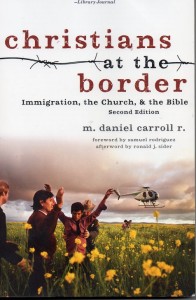Book Review: Christians at the Border by M. Daniel Carroll R.
Disclosure: I received this book through a Goodreads giveaway on the premise that I would review it.
Daniel Carroll is a professor of Old Testament at Denver, whose mother was Guatemalan, and who has divided his time between the U.S. and Guatemala since he was young. As such, he has ties to both mainstream American and Latino culture. In this updated edition (first version published in 2008) he speaks to the issue of immigration from a Biblical perspective.
He covers the history of immigration, primarily Hispanic, into the U.S. starting in 1848, and its ebbs and flows. There’s a look at the question of cultural identity and the economic impact of illegal immigration. Unlike many articles on the subject, he also writes about the effect on the countries the immigrants are from.
Then he really warms to the theme of the Christian dimension of Hispanic immigration, citing its invigorating effects on American religious life, and an understanding of the “sojourner” theme in the Bible. He refers to several different experiences in the Old Testament of immigration, including the stories of Ruth and Esther.
The book also looks at the Old Testament laws regarding “the stranger and the foreigner in your midst.” Mr. Carroll claims this is different from similar law codes of the same time period in the Middle East because those others do not have laws to deal with immigration, and because they are influenced by the Hebrew people’s own experience in Egypt.
But the stranger that dwelleth with you shall be unto you as one born among you, and thou shalt love him as thyself; for ye were strangers in the land of Egypt: I am the Lord your God. Leviticus 19:34
Turning to the New Testament, Mr. Carroll admits Jesus didn’t say anything about the specific topic of immigration, but he did spend time reaching out to the despised and those outside Judean society. The parable of the Good Samaritan indicates that tribal identification is less important than a person’s behavior to determine who is a “neighbor” to be loved.
!st Peter extends a metaphor of all Christians as sojourners in strange lands. And last, Mr. Carroll examines Romans 13, which is often used as a “clobber text” against undocumented immigrants. If they are here illegally, they are breaking the law, and we need give them no further consideration, end of discussion. But he feels this text should be examined in the context of Romans 12; discerning submission, rather than blind obedience.
The book wraps up with a call to Christians to make their decisions on how to treat immigrants, legal or otherwise, with a view to what the Bible teaches and the example of Jesus.
The text is clear and in understandable language, with a logical progression of thought. The introduction by Samuel Rodriguez of the National Hispanic Christian Leadership Conference is a bit more jargon-laden. There’s also an afterword by Ronald J Sider of Evangelicals for Social Action.
For further study, there’s an appendix of resources including websites, both pro- and anti-immigration. There are extensive endnotes and a small index.
This book will be of most interest to Christians, particularly of the evangelical persuasion, searching for perspective on the issue of immigration. People interested in the immigration issue who are not Christian might also find it helpful to understand the Biblical perspective.
To quote again, May the Lord illumine us and grant us understanding.


1 comment
Comments are closed.